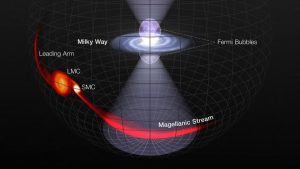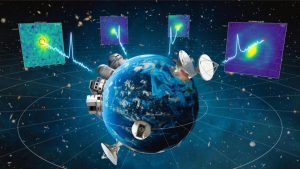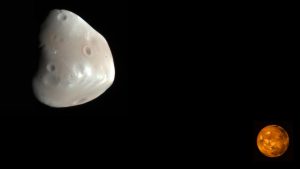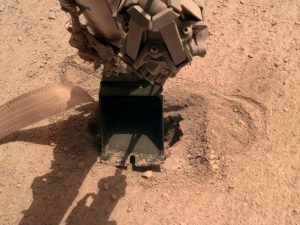Media
Transcript
The summer meeting of the American Astronomical Society (AAS) is over, but the science rolls on and on. There is a lot going on in the world, but for now, at least, we’re going to focus on beyond our atmosphere.

Our first story of the day taught me a new term: Fermi bubbles. Named after the gamma-ray telescope that discovered them, these dramatic regions of heated gas extend above and below the disc of our Milky Way galaxy, and were created during high-energy events involving our galaxy’s supermassive black hole (SMBH). First discovered in 2010, we’re still trying to understand these structures, what formed them, and how far-reaching an effect that source event may have had. It’s currently thought they most likely formed when 100,000 solar masses of material formed an accretion disk near our SMBH. As the material orbited rapidly toward its death, flashes were released that energized the surrounding gas that formed these globes.
New research shared yesterday at the AAS meeting shows that the event related to the Fermi bubble formation had much more distant effects than previously realized. Beyond energizing the Fermi bubbles, the light ionized gas as far away as the Magellanic Stream: the stream of material pulled off the Magellanic Clouds as these galaxies race past the Milky Way. According to project Principal Investigator Andrew Fox, “The flash was so powerful that it lit up the stream like a Christmas tree—it was a cataclysmic event! This shows us that different regions of the galaxy are linked—what happens in the galactic center makes a difference to what happens out in the Magellanic Stream. We’re learning about how the black hole impacts the galaxy and its environment.”
The ionized gas can’t be directly seen. Instead, it was mapped out by taking spectra of distant quasars and looking for absorption lines in the quasar light from the relatively nearby gas. Since every atom, and every ionization state of atoms, has a unique fingerprint of absorption or emission lines, the team was able to get not just the composition of the absorbing gas, but also its ionization state. This is a nice clean result, and scientists are even able to figure out roughly when the high-energy flare in our Milky Way took place. It turns out that had you been an early hominid on the Earth 3.5 to 2.5 million years ago, you would have seen the galactic core in Sagittarius shine with the ghostly glow of this likely million-year long event. This is one of the few times we know that a galaxy shaping event would have been visible to the unaided eye.
Our Earth was unaffected by this particular event, but other worlds, closer to the core of the galaxy, may not have been so lucky. Once again we are reminded, it’s all about location location location.

One of the most energetic, and still unexplained, phenomena are Fast Radio Bursts (FRBs). These momentary bursts, that in a few rare instances repeat, emit the same energy in seconds that our Sun will release across 80 years. Part of understanding what they require means just understanding where they are. New research from Australia’s Commonwealth Scientific and Industrial Research Organisation (CSIRO), has been able to catch four of these systems bursting and precisely identified their place in the sky. They appear to be in the outskirts of galaxies, ruling out SMBHs as the source. This work is published in the Astrophysical Journal Letters (ApJL) with lead author Shivani Bhandari. While this paper still doesn’t tell us exactly what the source of these objects is, the location hints that it could be aged objects undergoing dramatic interactions, such as neutron stars or white dwarfs. More research is still needed, but this is a major step forward.

From the distant universe we now look closer to home. We have a pair of stories about the red planet. Using new dynamical models, scientists at the SETI Institute and Purdue University, led by Matija Ćuk, have found new evidence that Mars has had small rings in the past and will likely have them again in the future. This is all part of a cyclic ring theory for Mars. As a stellar astronomer, I’m going to choose to quote from the press release on this one, because I can’t find a better explanation than what they’ve already provided. “Mars’s inner moon, Phobos, is losing height as its tiny gravity is interacting with the looming Martian globe. Soon, in astronomical terms, Phobos’s orbit will drop too low, and Mars’s gravity will pull it apart to make a ring around the planet. Hesselbrock and Minton proposed that over billions of years, generations of Martian moons were destroyed into rings. Each time, the ring would then give rise to a new, smaller moon to repeat the cycle over again.
“This cyclic Martian moon theory has one crucial element that makes Deimos’s tilt possible: a newborn moon would move away from the ring and Mars. Which is in the opposite direction from the inward spiral Phobos is experiencing due to gravitational interactions with Mars. An outward-migrating moon just outside the rings can encounter a so-called orbital resonance, in which Deimos’s orbital period is three times that of the other moon.
“These orbital resonances are picky but predictable about the direction in which they are crossed. We can tell that only an outward-moving moon could have strongly affected Deimos, which means that Mars must have had a ring pushing the inner moon outward. Ćuk and collaborators deduce that this moon may have been 20 times as massive as Phobos, and may have been its “grandparent” existing just over 3 billion years ago, which was followed by two more ring-moon cycles, with the latest moon being Phobos.”
We don’t normally use that large a quote, but our hat is off to Press Release author Rebecca McDonald for that clear description. What is particularly nice about this result is that it has related compositional predictions, and if this theory is true, JAXA’s future Phobos lander will prove or disprove this published idea. You can read more in a future ApJL paper.

Finally, we have two quick news notes. With a lot of help from NASA InSight’s shovel, the mole thermal instrument has finally made its way fully into the ground on Mars. It is unknown if it will be able to bury itself any further, but it is at least now out of sight in the dirt.
Also, a new CubeSat that was designed by NASA’s Jet Propulsion Laboratory to test just how much science you can pack into an orbital briefcase has been able to detect a known exoplanet orbiting 55 Cancri. This shows they can do high-quality pointing, get high-quality photometry, and all from something that was basically tossed off the ISS and into orbit.
Learn More
Flash from Milky Way’s Black Hole Illuminated Gas Outside Our Galaxy
- HubbleSite news release
- “Kinematics of the Magellanic Stream and Implications for Its Ionization,” Andrew J. Fox, Elaine M. Frazer et al., 2020, to appear in the Astrophysical Journal (Preprint)
Zooming In on the Origins of Fast Radio Bursts
- CSIRO press release
- “The Host Galaxies and Progenitors of Fast Radio Bursts Localized with the Australian Square Kilometre Array Pathfinder,” Shivani Bhandari et al., 2020 June 1, Astrophysical Journal Letters (Preprint on arxiv.org)
Martian Moon’s Orbit Hints at Ancient Ring
NASA InSight lander finally pushes its burrowing ‘mole’ into Mars
CubeSat Breaks Record for Smallest Satellite to Detect an Exoplanet
Credits
Written by Pamela Gay
Hosted by Pamela Gay
Audio and Video Editing by Ally Pelphrey
Content Editing by Beth Johnson
Intro and Outro music by Kevin MacLeod, https://incompetech.com/music/


 We record most shows live, on Twitch. Follow us today to get alerts when we go live.
We record most shows live, on Twitch. Follow us today to get alerts when we go live.